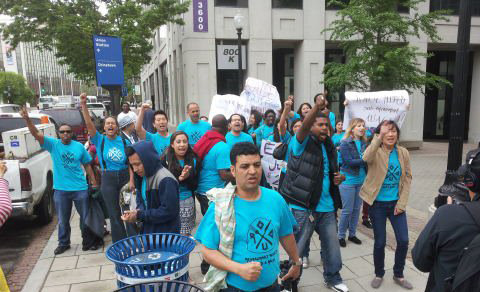
WASHINGTON – Can you imagine trying to live on $2.13 an hour, with no sick days, a 1-in-10 chance of having health care coverage, and paychecks that sometimes declare “this is not a paycheck” and come with a figure of “$0.00?”
Well, welcome to the world of restaurant workers – all 10 million of them.
Those are conditions a typical restaurant worker often faces, as described by Saru Jayaraman, head of the union-supported Restaurant Opportunities Center. This organization of restaurant workers that started in New York has spread to other cities, including Washington, Chicago, Philadelphia and Los Angeles.
That’s because those workers exist on what’s called the “tipped minimum wage,” of $2.13 per hour, far below the current federal minimum wage of $7.25. Tips, given to servers and distributed among all staff, are supposed to make up the difference, and more. Except they don’t.
Restaurant managers skim off excessive sums, and the biggest chain is the worst at enforcing the tipped wage rules, Jayaraman said. She spoke to a crowd at the AFL-CIO on Feb. 20 who gathered to hear her talk about her new book, Beyond The Kitchen Door, telling the stories of those workers and backing them with data.
Video book trailer (article continues after the video)
Many of the workers get most of their pay in cash, and that depends on customers’ generosity. “In no other industry are the workers directly dependent on customers for their pay,” Jayaraman added.
Pay isn’t the only problem the restaurant workers face. Vickie Lewis, head of the ROC’s D.C. branch, used to work as a bartender, until she got fired for being sick. The firing happened only after she came to work for days with contagious conjunctivitis – “pink eye” – before her doctor ordered her to stay home. Her bar lacked sick leave.
“Would you want somebody sick like me mixing your martini?” Lewis asked.
Restaurant workers, many them immigrants, women and single mothers, are among the lowest-paid groups of workers in the U.S., federal data show. The restaurant owners lobby, the National Restaurant Association, is not only trying to keep them that way here, Jayaraman added, but lobbies to extend U.S. “standards” abroad.
Her group is fighting back with the aid of videos and films, including some produced by noted activist Danny Glover. It’s also issued a guide to “best practices’ restaurants should use to raise their workers’ standard of living. Jayaraman’s book is another tool, as is mobilization not just of the restaurant workers, but of consumers, too.
The owners’ lobby, which Jayaraman compared to that other powerful D.C. “NRA” lobby-the National Rifle Association-is fighting back by tailing her public appearances and campaigning against raising the minimum wage, not just for tipped workers, but for all workers. The tipped minimum hasn’t been raised in 22 years, but legislation introduced in Congress would increase it to 60% of the regular minimum.
“$7.25 an hour? Who can live on that?” Jayaraman says of the national minimum wage, which Democratic President Barack Obama wants to raise to $9 and index to inflation. “But $2.13 is beyond the pale.”
The owners’ lobby is also fighting its own workforce in the states. Its Florida affiliate tried to cut the state’s tipped minimum of $4.65 hourly down to $2.13. ROC and its allies raised so much uproar that a leading restaurant chain quit the Florida group and the GOP-run legislature defeated the cut.
This year, the fight is in Illinois. The legislature is considering raising the state’s minimum wage, and leaving the tipped minimum workers out. “The NRA is at its loudest there. If we lose in Illinois, it could be terrible nationwide,” adds Jayaraman.
By contrast, in seven states, including California and Alaska, the tipped minimum wage is equal to the national $7.25 hourly minimum. The cost? “About a dime a day” per diner, Jayaraman says.
Consumers can also act individually to support the workers, who are deliberately not trying to organize into a union, given the hurdles they face in U.S. labor law. One is to use the resources of ROC’s website, including its videos and films. Another is to purchase Jayaraman’s book. And don’t forget to leave good tips, she says.
But the most powerful, she adds, is to buy and use the ROC best practices guide, exercising the consumers’ power of the purse. Go to a restaurant, have a meal, pay the bill, leave a nice tip, then ask to see the manager or owner.
Say you enjoyed the meal and would like to come back again, and will – if the restaurant treats its workers right. Then show the guide, with its program of a decent wage, health insurance, paid sick leave, a seniority ladder and no discrimination in promotions. Because racial discrimination is yet another problem restaurant workers face: Too many minorities as dishwashers and cooks, too few as hosts and hostesses.
“We don’t want you to stop eating out or even boycott,” Jayaraman says. “We want you to have a fun time, enjoy your meal, and use your power” for the workers.
Photo: ROC flashmob at NRA conference as NRA members boarded buses to lobby congress on anti-worker agenda. ROC Facebook page.









